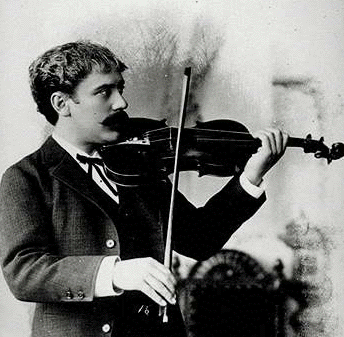Some Thoughts on Beethoven's Violin Concerto
The serenity and majesty of Beethoven’s famed Violin Concerto belie the turmoil of its time: Vienna was under French occupation and Beethoven was coming to terms with his increasingly profound deafness.
Despite its popularity today, the Violin Concerto did not receive a warm reception at its premiere on December 23, 1806. The soloist, Franz Clement, received the soloist’s part a matter of days before the performance and Beethoven’s nearly illegible writing in the orchestra’s parts undoubtedly contributed to an underwhelming performance; indeed, between the first two movements the audience’s apparently poor response led Clement to turn his violin upside down and improvise a folksy tune in order to reclaim their attention and good graces! Beethoven felt discouraged by the Concerto’s reception and made a version for piano with orchestra. Although a full score manuscript exists (and I own a beautiful facsimile edition published in 1979), it leads to more questions than answers, as Beethoven has notated many different versions of passages – partly in preparing the piano version – without indicating his final selection. Even the fact that he “proofread and authorized” the first edition (published in 1808) does not convince that what we now know as his Violin Concerto is exactly as he would wish it to sound, due to his impatience in attending to the details of an error-free score.
In any event, the work was in danger of fading into oblivion before being “revived” in 1844 – seventeen years after Beethoven’s death – by Felix Mendelssohn, with the 13-year-old violinst Joseph Joachim as soloist. Time, of course, has established the Concerto as among the great works of the Classical repertoire.
Lately I have been especially aware of Beethoven’s masterful use of the perfect cadence, from the solo violin’s first entry through many moments throughout each movement, much like the music of Bach. Although the perfect cadence marks the “resolution” of a musical idea, each of these masters continues the narrative in another guise, leading the listener (and performer) ever forward through a variety of affects or emotions and ultimately to the conclusion of the movement. Beethoven’s use of what I call a “motor” – in the first movement the motif of four even pulses – also determines how feely the soloist plays. When the motor is reduced to one slow pulse per measure in the section in g minor, for example, the effect is that of time standing nearly still and melancholy. Like other great composers, Beethoven also uses chromaticism to create further uncertainty in the listener – where are we going with this? – and he does so to lead this section into a triumphant return of the opening music. Yet, even following an enormously powerful tutti, in which horns are blazing and strings are energetically propelling the music along, he reminds the soloist to play “dolce” – sweetly!
Another source of inspiration is the poetic nature of the Larghetto, which is in the form of a Romance – much like Beethoven’s Romances in F and G for violin and orchestra. (Essentially, a Romance features a musical statement, characterized by simplicity, that is returned to throughout the work with a slight alteration of affect each time and with variations in between.) The Larghetto differs from the other Romances in that the violin is frequently accompanying the orchestra and providing commentary in an improvisatory manner specified by Beethoven’s notes.
Beethoven suddenly and dramatically breaks the serene mood of the Larghetto and leads into a Rondo; taking everyone with him in a quick transition from the sublime to the extremely folksy. Although the Rondo features “simpler” music – with an emphasis on the “hunting call” intervals of a fifth – it is important to phrase it carefully and keep its 6/8 meter from sounding singsong. I also request that the strings use a lot of open strings when they play their tuttis, in keeping with the idea of country fiddles playing a delightful dance. Late in the movement Beethoven pulls the ultimate surpise when he moves the tune from D Major to A-flat Major – again, what is this? – before heading into a powerful coda and a series of harmonic points that undoubtedly inspired Rossini (and the composer of “Heart and Soul”!)
Beethoven did not provide his violin soloist with cadenzas – the spot at which the orchestra ceases to play and the soloist is supposed to play improvisations based on the movement’s music – so I have composed my own. While pondering how to even get started, I asked my dear, late pianist friend Bill Black for advice. His response: modulate quickly and as far away from the home key as possible, which has led me to play the second theme in double stops in f minor, which is about as far away from D Major as you can get. I also insert a little cadenza into the third movement where other violinists traditionally do not (partly to keep the conductor on his or her toes), but it is also a place where Beethoven indicated an eingang (literally, lead-in or entry) as he prepared the version of the Concerto for piano soloist. Otherwise, I enjoy putting in bits of the orchestra’s music that don’t appear in the soloist’s part, often “upside down.”
This work demands the ultimate clarity and beauty of musical line, sound, intonation and articulation, which cannot be achieved with virtuosic bluster or exaggeration, and I always examine it carefully for new insights. Even after years of performances – and having made a recording of it (on original instruments) – I approach it with contemplation and the appreciation of an enduring relationship that only deepens over time.



















